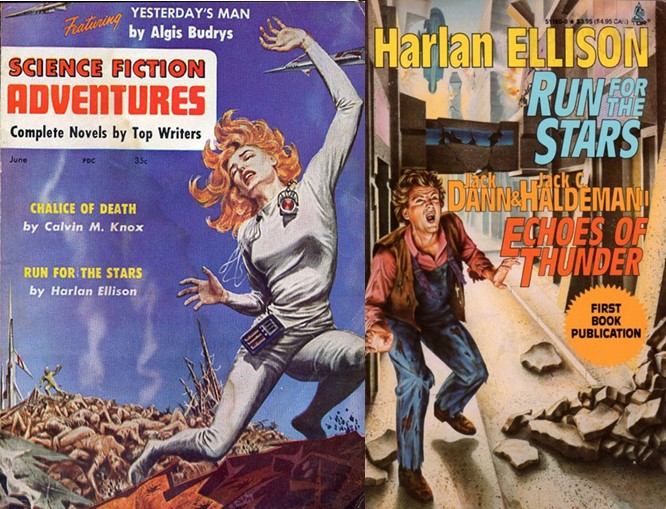Tor Doubles #32: Harlan Ellison’s Run for the Stars and Jack Dann and Jack Haldeman II’s Echoes of Thunder

Tor Double number #32 was originally published in April 1991 and includes Echoes of Thunder, an original story, in this form, for the Tor Double line, which, as with the Popkes story a couple volumes earlier, has not been reprinted in this form. This is Dann and Haldeman’s only appearance in the series. It also includes Harlan Ellison’s only appearance in the series.
Run for the Stars was originally published in Science Fiction Adventures in June 1957. Ellison has noted this as the author’s preferred edition of the story.
Benno Tallant is a drug addict on war torn Deald’s World. While ransacking the corpse of a grocer for money with which to buy drugs, he is taken prisoner by three men who need his assistance in their attempt to keep Earth safe from invasion of the alien Kyban, whose fleet is preparing to destroy the human outpost on Deald’s World.
Deald’s World, at least the part that Ellison has elected to share with the reader, is filled with unsavory characters. In addition to Tallant, the men who abducted him view themselves as saviors of the human race and are clearly willing to do whatever it takes to achieve that goal, even if it means inserting a massive explosive device in a random drug addict they managed to find. Their doctor who performed the surgery, is similarly an addict who has no qualms about performing the surgery on an unwilling person if it means he can get his own addiction sated.
Tallant’s abductors leave Deald’s World, letting the Kyban know that any attempt to follow them will result in an explosion that will wipe out their fleet from a bomb based on the world, he is left on the vacant planet, knowing that the longer he can avoid the Kyban, the longer he can survive, although also knowing that eventually, the bomb will kill him, if he can’t figure out a way to disarm it.
There is a vague similarity between Run for the Stars and Tom Godwin’s seminal 1954 story “The Cold Equations.” In both stories, the problem of the character’s survival is a thought experiment created by the author to figure out how to solve the problem. In “The Cold Equations,” the question is how to rescue Marilyn, the stowaway, when the author has completely stacked the deck against her. In Run for the Stars, it is how Tallant can survive when his own species has booby-trapped him and left him on a world being invaded by the enemy Kyban, who are ordered to kill any humans on sight.
As with “The Cold Equations,” Run for the Stars suffers due to the contrived nature of the situation Tallant finds himself in. In the Godwin article, part of the author’s intent was to make Marilyn as sympathetic as possible, a concern Ellison clearly didn’t have with Tallant. While Marilyn is in a position of powerlessness, both against the physics of the situation and Barton, the pilot, Tallant is portrayed as an addict, but one who could almost be a Heinlein hero when it comes to his ability to hide from, out think, and kill the Kyban.
The Kyban, themselves, are portrayed in this story in somewhat generic terms. Their purpose in the story is almost a maguffin to put Tallant into the untenable situation in which he finds himself and see how he can manage to survive, if not reform as an individual. Ellison wrote several stories about the Earth-Kyban war between 1956 and 1987, perhaps the most famous of which is the Outer Limits episode “Demon with a Glass Hand.” There is clearly more to these aliens than appears in this story.
Ultimately, Run for the Stars does not work on its own. Rather than a fully fleshed out world with complex characters, it is more designed as a proving ground for the situation Ellison has set up to run Tallant through. Unable to interact with any other characters in a meaningful way, Tallant is portrayed as either an addict who is doing anything to get his fix or a superman whose abilities seem to arise simply because the situation requires it. There is little humanity in the character and nothing to earn the reader’s sympathy.

Tor Double #330 cover by Barclay Shaw
Echoes of Thunder by Jack Dann and Jack C. Haldeman II has an interesting history. In 1982, Haldeman and Dann collaborated on a short story entitled “High Steel.” Originally published in the February issue of The Magazine of Fantasy and Science Fiction, “High Steel” went on to receive a Nebula nomination for best short story. That short story forms the first 37 pages of Echoes of Thunder, which received its initial publication in the Tor Double series. The remainder of Echoes of Thunder was published in F&SF in February 1988 as “The Sentry.” Eventually, this story was expanded to form the novel High Steel, which was published by Tor Books in 1993.
Dann and Haldeman tell the story of John Stranger, a Native American who was drafted to work construction on space stations at the same time he was completing his vision quest. Although the wichasha wakan who guided him, Broken-finger, believed he had the potential to become a great “medicine man,” the draft notice meant that he was required to go into space, as were many other members of the Lakota.
The first part of the novella focuses on the work Stranger and his companions are doing in space, showing them to be a tight-knit group, even when they have issues amongst themselves. They can always, however, band together against management and the bellmen, who directed their activities from the safety of the space station. Stranger clearly holds a position of authority, working on the structure with two other Native Americans, Anna Grass-like-light and Sam Woquini.
The three are almost archetypes for depictions of native Americans, with Stranger being a potential medicine man who rejects everything the white man has to offer while forced to live among them, Sam is true to his roots, but not entirely attuned to them, and Anna has turned her back on her culture, practically assimilating and rubbing Stranger’s face in the fact that she views herself as being one of the wasicum. When things go wrong, John is only saved by his own contrariness and stubbornness.
The second part of the novella expands the author’s worldview. Having established what life was like on the space station for John, Sam, and Anna, they are now able to put the space stations into context. Rather than being drafted by the government, they were drafted by a corporation, one of many which fought with each other to gain supremacy on Earth and in Space. Stranger has come to the attention of the Director of his corporation, Gerard Lincoln Smith Leighton, who views him as a competent troublemaker, the perfect tool to exploit against rival corporations.
Against this activity, Broken-finger continues to try to teach the Native Americans who haven’t been called up by the corporations and to find other potential wichasha wakan, although none of the candidates are as strong as Stranger. Eventually, he shares a vision with Stranger that includes instructions Broken-finger received from Stranger’s deceased father, which helps Stranger realize how he is being used by the corporation.
Because of the nature of the story, it feels like two different parts of Stranger’s tale, rather than naturally flowing from the first part to the second. Similarly, the novella ends abruptly, with the promise of more to come as the authors are clearly setting up the next part of what was to become the novel High Steel, which means that the ending of Echoes of Thunder is less than satisfying, offering a tantalizing hint rather than a conclusion.
Echoes of Thunder and the novel it formed part of, High Steel, came out at the same time Allen Steele was mining the same territory, describing the exploits of the workers who built space stations in earth orbit, in novels like Lunar Descent, Orbital Decay, and Clarke County Space. While Dann and Haldeman put their own twist on it, particularly with the inclusion of Native American culture, Echoes of Thunder does not stand up to the Steele novels, potentially because it is merely part of a story, hinting at something more to come.
Barclay Shaw provided the cover.
 Steven H Silver is a twenty-one-time Hugo Award nominee and was the publisher of the Hugo-nominated fanzine Argentus as well as the editor and publisher of ISFiC Press for eight years. He has also edited books for DAW, NESFA Press, and ZNB. His most recent anthology is Alternate Peace and his novel After Hastings was published in 2020. Steven has chaired the first Midwest Construction, Windycon three times, and the SFWA Nebula Conference numerous times. He was programming chair for Chicon 2000 and Vice Chair of Chicon 7.
Steven H Silver is a twenty-one-time Hugo Award nominee and was the publisher of the Hugo-nominated fanzine Argentus as well as the editor and publisher of ISFiC Press for eight years. He has also edited books for DAW, NESFA Press, and ZNB. His most recent anthology is Alternate Peace and his novel After Hastings was published in 2020. Steven has chaired the first Midwest Construction, Windycon three times, and the SFWA Nebula Conference numerous times. He was programming chair for Chicon 2000 and Vice Chair of Chicon 7.